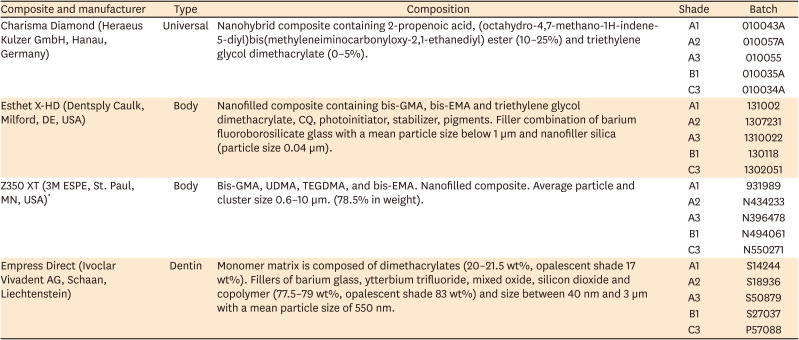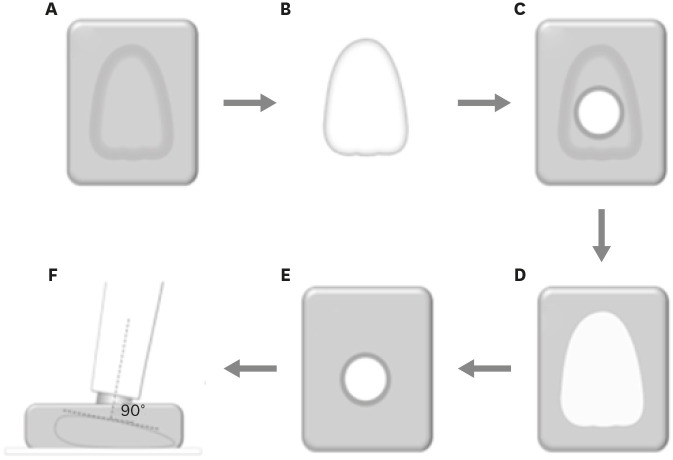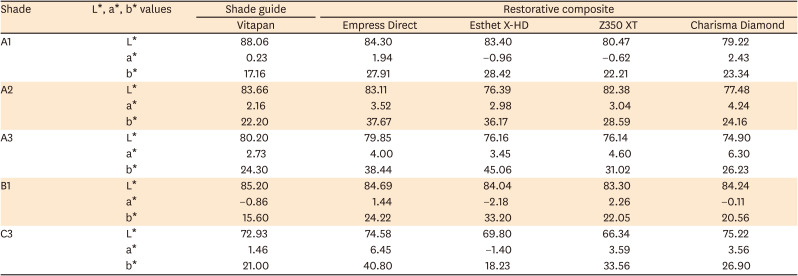1. Glockner K, Glockner K, Haiderer B. Visual vs. spectrophotometric methods for shade selection. Coll Antropol. 2015; 39:801–802. PMID:
26898085.
2. Miyajiwala JS, Kheur MG, Patankar AH, Lakha TA. Comparison of photographic and conventional methods for tooth shade selection: a clinical evaluation. J Indian Prosthodont Soc. 2017; 17:273–281. PMID:
28936042.

3. Bergen SF, McCasland J. Dental operatory lighting and tooth color discrimination. J Am Dent Assoc. 1977; 94:130–134. PMID:
264306.

4. Kim BJ, Lee YK. Influence of the shade designation on the color difference between the same shade-designated resin composites by the brand. Dent Mater. 2009; 25:1148–1154. PMID:
19446871.
5. Lee YK, Yu B, Lee SH, Cho MS, Lee CY, Lim HN. Shade compatibility of esthetic restorative materials--A review. Dent Mater. 2010; 26:1119–1126. PMID:
20832851.
6. Browning WD, Contreras-Bulnes R, Brackett MG, Brackett WW. Color differences: polymerized composite and corresponding Vitapan Classical shade tab. J Dent. 2009; 37(Supplement 1):e34–e39. PMID:
19500895.
7. Lehmann KM, Igiel C, Schmidtmann I, Scheller H. Four color-measuring devices compared with a spectrophotometric reference system. J Dent. 2010; 38(Supplement 2):e65–e70. PMID:
20659526.

8. Oh WS, Koh IW, O'Brien WJ. Estimation of visual shade matching errors with 2 shade guides. Quintessence Int. 2009; 40:833–836. PMID:
19898714.
9. Paolone G, Orsini G, Manauta J, Devoto W, Putignano A. Composite shade guides and color matching. Int J Esthet Dent. 2014; 9:164–182. PMID:
24765625.
10. Swift EJ Jr, Hammel SA, Lund PS. Colorimetric evaluation of vita shade resin composites. Int J Prosthodont. 1994; 7:356–361. PMID:
7993547.
11. Igiel C, Lehmann KM, Ghinea R, Weyhrauch M, Hangx Y, Scheller H, Paravina RD. Reliability of visual and instrumental color matching. J Esthet Restor Dent. 2017; 29:303–308. PMID:
28742283.
12. Yılmaz B, Irmak Ö, Yaman BC. Outcomes of visual tooth shade selection performed by operators with different experience. J Esthet Restor Dent. 2019; 31:500–507. PMID:
31228358.

13. Barutcigil C, Harorli OT, Yildiz M, Ozcan E, Arslan H, Bayindir F. The color differences of direct esthetic restorative materials after setting and compared with a shade guide. J Am Dent Assoc. 2011; 142:658–665. PMID:
21628688.

14. Hassel AJ, Doz P, Nitschke I, Rammelsberg P. Comparing L*a*b* color coordinates for natural teeth shades and corresponding shade tabs using a spectrophotometer. Int J Prosthodont. 2009; 22:72–74. PMID:
19260432.
15. Kim HS, Um CM. Color differences between resin composites and shade guides. Quintessence Int. 1996; 27:559–567. PMID:
9161260.
16. Paravina RD, Kimura M, Powers JM. Color compatibility of resin composites of identical shade designation. Quintessence Int. 2006; 37:713–719. PMID:
17017633.
17. Sampaio CS, Gurrea J, Gurrea M, Bruguera A, Atria PJ, Janal M, Bonfante EA, Coelho PG, Hirata R. Dental shade guide variability for hues B, C, and D using cross-polarized photography. Int J Periodontics Restorative Dent. 2018; 38:s113–s118. PMID:
29677224.

18. Nakhaei M, Ghanbarzadeh J, Amirinejad S, Alavi S, Rajatihaghi H. The influence of dental shade guides and experience on the accuracy of shade matching. J Contemp Dent Pract. 2016; 17:22–26. PMID:
27084858.

19. Alvim HH, Alecio AC, Vasconcellos WA, Furlan M, de Oliveira JE, Saad JR. Analysis of camphorquinone in composite resins as a function of shade. Dent Mater. 2007; 23:1245–1249. PMID:
17204320.

20. Rocha Maia R, Oliveira D, D'Antonio T, Qian F, Skiff F. Comparison of light-transmittance in dental tissues and dental composite restorations using incremental layering build-up with varying enamel resin layer thickness. Restor Dent Endod. 2018; 43:e22. PMID:
29765902.

21. Salgado VE, Albuquerque PP, Cavalcante LM, Pfeifer CS, Moraes RR, Schneider LF. Influence of photoinitiator system and nanofiller size on the optical properties and cure efficiency of model composites. Dent Mater. 2014; 30:e264–e271. PMID:
24985934.

22. Azzopardi N, Moharamzadeh K, Wood DJ, Martin N, van Noort R. Effect of resin matrix composition on the translucency of experimental dental composite resins. Dent Mater. 2009; 25:1564–1568. PMID:
19709725.

23. Chu SJ, Trushkowsky RD, Paravina RD. Dental color matching instruments and systems. Review of clinical and research aspects. J Dent. 2010; 38(Supplement 2):e2–ee16. PMID:
20621154.

24. Elgendy H, Maia RR, Skiff F, Denehy G, Qian F. Comparison of light propagation in dental tissues and nano-filled resin-based composite. Clin Oral Investig. 2019; 23:423–433.

25. Gulamali AB, Hemmings KW, Tredwin CJ, Petrie A. Survival analysis of composite Dahl restorations provided to manage localised anterior tooth wear (ten year follow-up). Br Dent J. 2011; 211:E9. PMID:
21869770.

26. Moura FR, Romano AR, Lund RG, Piva E, Rodrigues Júnior SA, Demarco FF. Three-year clinical performance of composite restorations placed by undergraduate dental students. Braz Dent J. 2011; 22:111–116. PMID:
21537583.

27. Wolff D, Kraus T, Schach C, Pritsch M, Mente J, Staehle HJ, Ding P. Recontouring teeth and closing diastemas with direct composite buildups: a clinical evaluation of survival and quality parameters. J Dent. 2010; 38:1001–1009. PMID:
20826192.









 PDF
PDF Citation
Citation Print
Print



 XML Download
XML Download